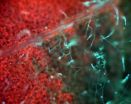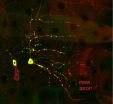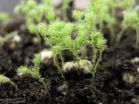(Press-News.org) SAN ANTONIO — Exemestane, an aromatase inhibitor that blocks production of estrogen, may provide another post-surgery option for postmenopausal women with hormone-receptor positive, early-stage breast cancer.
In the first head-to-head adjuvant clinical trial comparing two aromatase inhibitors, anastrozole and exemestane, the drugs resulted in similar survival rates and prevention of breast cancer recurrences. Some differences in the side effect profile were seen, including a potential difference in the risk of developing osteoporosis.
Paul E. Goss, M.D., Ph.D., professor of medicine at Harvard Medical School in Boston, presented detailed results of this study at the 33rd Annual CTRC-AACR San Antonio Breast Cancer Symposium, held Dec. 8-12, 2010.
In hormone-receptor positive breast cancer estrogen stimulates tumor growth. Currently, patients undergo surgery and then receive drugs that stop estrogen production for five years. Aromatase inhibitors block an enzyme, which is responsible for converting androgens to estrogens.
In previous research, aromatase inhibitors have shown superiority over standard endocrine therapies, with anastrozole and letrozole as the only drugs in the class approved by the U.S. Food and Drug Administration (FDA) as a first-line, adjuvant therapy.
But Goss said investigators had hypothesized that another class of aromatase inhibitors, of which exemestane is an example, may be more potent and have a more favorable side effect profile, including less damage to bones, organs and lipid metabolism.
"The difference in the drug class is that anastrozole is a non-steroidal inhibitor and exemestane is a steroidal inhibitor," said Goss.
To test this hypothesis, the NCIC Clinical Trials Group at Queen's University, Canada, led a large, randomized clinical trial comparing the two treatments among 7,576 women from Canada, the United States and Europe. The trial included support from the U.S. National Cancer Institute's Cancer Therapy Evaluation Program and the European-based International Breast Cancer Study Group.
"We found that the drugs are comparable in terms of preventing recurrent breast cancer and in overall survival," said Goss. "Osteoporosis was reported less frequently and cholesterol levels appeared to be lower in patients on exemestane than anastrozole. Other side effects such as mood change and abnormalities of blood tests assessing liver function were reported more frequently with exemestane, although, the overall numbers of these events were small. With these results, exemestane should be considered as an alternative to anastrozole for initial adjuvant therapy."
Exemestane is currently approved by the FDA when used following tamoxifen, a standard endocrine therapy, or as a second-line therapy for metastatic breast cancer.
"The three available aromatase inhibitors are due to come off patent and these results provide another alternative for the most commonly prescribed medication for breast cancer globally," he said.
The good news for patients is how well women in this trial did, with a reported 91 percent overall survival rate after more than four years of follow-up, according to Goss. "The results are likely as a result of a combination of many advances including screening, surgery, radiation, chemotherapy and endocrine therapy," he said.
Initially, the researcher's clinical trial also included investigating the role of a COX-2 inhibitor called celecoxib when used in combination with the aromatase inhibitors. Less than two years into this seven-year trial, this portion of the study was discontinued because of concerns about heart problems associated with COX-2 inhibitors. A total of 1,635 women had received celecoxib at that time.
COX-2 inhibitors are nonsteroidal anti-inflammatory drugs that reduce inflammation by blocking COX-2 enzyme, which is responsible for the pain and swelling associated with inflammation. They are also produced in response to precancerous and cancerous tissues.
"Therefore, the value of COX-2 inhibitors in reducing breast cancer recurrence remains unanswered," said Goss.
###
Follow the AACR on Twitter @AACR, and throughout the meeting using the hash tag #SABCS.
Recordings of the teleconferences and video interviews with researchers will posted to the AACR website throughout the meeting: http://www.aacr.org/page23506.aspx.
The mission of the CTRC-AACR San Antonio Breast Cancer Symposium is to produce a unique and comprehensive scientific meeting that encompasses the full spectrum of breast cancer research, facilitating the rapid translation of new knowledge into better care for breast cancer patients. The Cancer Therapy & Research Center (CTRC) at The University of Texas Health Science Center at San Antonio, the American Association for Cancer Research (AACR) and Baylor College of Medicine are joint sponsors of the San Antonio Breast Cancer Symposium. This collaboration utilizes the clinical strengths of the CTRC and Baylor, and the AACR's scientific prestige in basic, translational and clinical cancer research to expedite the delivery of the latest scientific advances to the clinic. The 33rd annual symposium is expected to draw nearly 9,000 participants from more than 90 countries.
Exemestane may be another first-line, adjuvant therapy for hormone-receptor positive, early-stage breast cancer
2010-12-10
ELSE PRESS RELEASES FROM THIS DATE:
Genome of barley disease reveals surprises
2010-12-10
Scientists have sequenced the genome of a major fungal disease that affects barley and other cereal crops, a breakthrough that could lead to significant advances in our understanding of how plant diseases evolve. The research, published today in the journal Science, suggests that parasites within the genome of the fungus help the disease to adapt and overcome the plant's defences.
The study could help with the development of new agricultural techniques for protecting cereal crops from infection. Barley grains are the basis of many staple foods, and also central to the ...
The end of planet formation, as told by trace elements from the mantles of Earth, the moon and Mars
2010-12-10
New research reveals that the abundance of so-called highly siderophile, or metal-loving, elements like gold and platinum found in the mantles of Earth, the Moon and Mars were delivered by massive impactors during the final phase of planet formation over 4.5 billion years ago. The predicted sizes of the projectiles, which hit within tens of millions of years of the giant impact that produced our Moon, are consistent with current planet formation models as well as physical evidence such as the size distributions of asteroids and ancient Martian impact scars. They predict ...
Gene hunters tackle crop diseases
2010-12-10
Norwich scientists are on the trail of some of the most economically damaging organisms that infect crops worldwide. Their latest targets are the parasitic water fungus that causes powdery mildew and the water molds that cause late blight in potatoes and tomatoes and downy mildew in cruciferous vegetables and other crops.
"We have been studying the late blight pathogen for a while," said Professor Sophien Kamoun, head of the Sainsbury Laboratory on the Norwich Research Park. "In separate research we are trialling plant genes that mediate blight resistance, while in this ...
Key protein discovered that allows nerve cells to repair themselves
2010-12-10
A team of scientists led by Melissa Rolls, an assistant professor of biochemistry and molecular biology at Penn State University, has peered inside neurons to discover an unexpected process that is required for regeneration after severe neuron injury. The process was discovered during Rolls's studies aimed at deciphering the inner workings of dendrites -- the part of the neuron that receives information from other cells and from the outside world. The research will be published in the print edition of the scientific journal Current Biology on 21 December 2010.
"We already ...
Thought for food: New CMU research shows imagining food consumption reduces actual consumption
2010-12-10
PITTSBURGH—If you're looking to lose weight, it's okay to think about eating your favorite candy bar. In fact, go ahead and imagine devouring every last bite — all in the name of your diet.
A new study by researchers at Carnegie Mellon University, published in Science, shows that when you imagine eating a certain food, it reduces your actual consumption of that food. This landmark discovery changes the decades-old assumption that thinking about something desirable increases cravings for it and its consumption.
Drawing on research that shows that perception and mental ...
Massive gene loss linked to pathogen's stealthy plant-dependent lifestyle
2010-12-10
An international team of scientists, which includes researchers from Virginia Tech, has cracked the genetic code of a plant pathogen that causes downy mildew disease. Downy mildews are a widespread class of destructive diseases that cause major losses to crops as diverse as maize, grapes, and lettuce. The paper describing the genome sequence of the downy mildew pathogen Hyaloperonospora arabidopsidis, which attacks the widely studied model plant Arabidopsis thaliana, is the cover story of this week's edition of the journal Science.
In the paper, the sequence of H. arabidopsidis ...
Cutting dietary phosphate doesn't save dialysis patients' lives
2010-12-10
Doctors often ask kidney disease patients on dialysis to limit the amount of phosphate they consume in their diets, but this does not help prolong their lives, according to a study appearing in an upcoming issue of the Clinical Journal of the American Society Nephrology (CJASN). The results even suggest that prescribing low phosphate diets may increase dialysis patients' risk of premature death.
Blood phosphate levels are often high in patients with kidney disease, and dialysis treatments cannot effectively remove all of the dietary phosphate that a person normally consumes. ...
Duchenne muscular dystrophy is ultimately a stem cell disease
2010-12-10
Researchers have long known that the devastating disease called Duchenne muscular dystrophy (DMD) is caused by a single mutation in a gene called dystrophin. The protein encoded by that gene is critical for the integrity of muscle; without it, they are easily damaged. But new findings in mice reported online in the journal Cell on December 9th by researchers at Stanford suggest that disease symptoms, including progressive muscle weakening leading to respiratory failure, only set in when skeletal muscle stem cells can no longer keep up with the needed repairs.
"This is ...
New mouse model for duchenne muscular dystrophy implicates stem cells, Stanford researchers say
2010-12-10
STANFORD, Calif. — For years, scientists have tried to understand why children with Duchenne muscular dystrophy experience severe muscle wasting and eventual death. After all, laboratory mice with the same mutation that causes the disease in humans display only a slight weakness. Now research by scientists at the Stanford University School of Medicine, and a new animal model of the disease they developed, points a finger squarely at the inability of human muscle stem cells to keep up with the ongoing damage caused by the disorder.
"Patients with muscular dystrophy experience ...
Adapting agriculture to climate change: New global search to save endangered crop wild relatives
2010-12-10
ROME (10 December 2010)—The Global Crop Diversity Trust today announced a major global search to systematically find, gather, catalogue, use, and save the wild relatives of wheat, rice, beans, potato, barley, lentils, chickpea, and other essential food crops, in order to help protect global food supplies against the imminent threat of climate change, and strengthen future food security.
The initiative, led by the Global Crop Diversity Trust, working in partnership with national agricultural research institutes, Royal Botanic Gardens, Kew, and the Consultative Group ...


